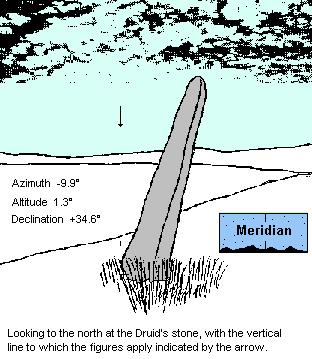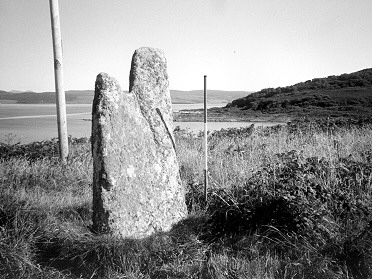
Druid's Stone, Gigha
Stones
of Wonder
QUICK LINKS ...
HOME PAGE
INTRODUCTION
WATCHING
THE SUN, MOON AND STARS
THE
MONUMENTS
THE
PEOPLE AND THE SKY
BACKGROUND
ARCHAEOASTRONOMY
USING
THE SITE DESCRIPTION PAGES
VISITING
THE SITES
THE
LEY LINE MYSTERY
THE
SITES
ARGYLL
AND ARRAN
MID
AND SOUTH SCOTLAND
NORTH
AND NORTH-EAST SCOTLAND
WESTERN
ISLES AND MULL
Data
DATES
OF EQUINOXES AND SOLSTICES, 1997 to 2030 AD
DATES
OF MIDSUMMER AND MIDWINTER FULL MOONS, 1997 to 2030 AD
POSTSCRIPT
Individual
Site References
Bibliography
Links
to other relevant pages
Contact
me at : rpollock456@gmail.com
Standing Stone NR655523*
How to find : From the shop/Post Office follow the only road on Gigha north for 3.5km, and the stone will be seen just beside the road. The stone is also referred to as 'Tarbert, Gigha'.
Best time of year to visit : Any clear night.
 This
is likely to be a Neolithic or Bronze age stone, despite its local
association with the Iron age priesthood.
This
is likely to be a Neolithic or Bronze age stone, despite its local
association with the Iron age priesthood.
The slab is over 2 metres tall, by about a metre wide and 40cm thick. It now leans badly to the east. The stone was surveyed as if it were standing vertically.
The resulting bearings were, to the north - 9.9°, and to the south - 189.9°. With the horizon value to the north of 1.3° we obtain a declination of +34.6°. To the south, the horizon is 1.1° and the resulting declination value is -33.0°. Neither of these lines fits for any position of the sun or moon in the sky.
It may be then that the stone was put up as a crude indication of the meridian, of which there are other examples in Argyll. The meridian can be found by watching the movement of the northern circumpolar stars. (See Salachary and Carnasserie sites for full description). However, the stone has sagged to one side and may also have twisted in its socket. Only excavation of the socket of the stone could reveal whether the axis of the stone was set north-south or in some other direction originally.

Druid's stone, looking south-east